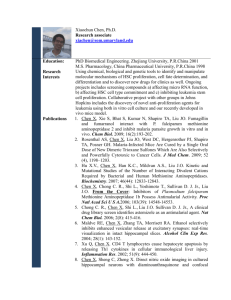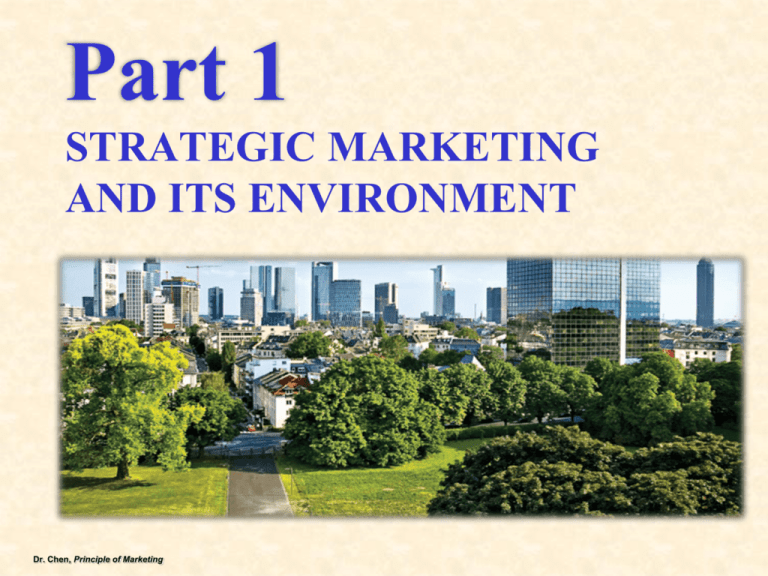
Part 1
STRATEGIC MARKETING
AND ITS ENVIRONMENT
Dr. Chen, Principle of Marketing
1: Customer-Driven Strategic
Marketing
2: Planning, Implementing, and
Evaluating Marketing
Strategies
3:The Marketing Environment,
Social Responsibility, and
Ethics
Dr. Chen, Principle of Marketing
Chapter 3
The Marketing Environment,
Social Responsibility, and
Ethics
Professor Jason C. H. Chen, Ph.D.
School of Business Administration
Gonzaga University
Spokane, WA 99258
chen@jepson.gonzaga.edu
Dr. Chen, Principle of Marketing
Learning Objectives
Recognize the importance of the marketing
environment
Understand the concept and dimensions of
social responsibility and ethics in marketing
Dr. Chen, Principle of Marketing
4
Environmental Forces
Competitive
Political
Economic
Environmental
Forces
Legal and
Regulatory
Technological
Sociocultural
Dr. Chen, Principle of Marketing
Marketing Environment
Monitoring the environment is crucial to
achieve long-term goals of the organization
Changes in the marketing environment
monitored by:
Environmental
scanning
Environmental analysis
Dr. Chen, Principle of Marketing
6
Marketing Environment
Environmental
scanning
________
Process of collecting
information about forces
in the marketing
environment which
involves:
Observation
Secondary sources such
as business, trade,
government, and Internet
sources
Marketing research
Dr. Chen, Principle of Marketing
Environmental
analysis
_________
Process of assessing and
interpreting information
gathered through
environmental scanning
Manager should be able to
identify potential threats and
opportunities linked to
environmental changes
How the manager deal with
the information collected
during scanning
7
Responding to Environmental Forces
Marketers take two approaches to environmental
forces:
Passive (reactive) – Accepting them as
uncontrollable
Proactive – Attempting to influence and shape them
constructive and bring desired results.
It can be ____________
E.g., The pharmaceutical industry (lobby for fewer
restrictions on prescription drug marketing).
No best way to react
Depends on the organization, management, and
the situation
Dr. Chen, Principle of Marketing
8
Competitive Forces
Competition – Other organizations that market
products that are similar to or can be substituted
for a marketer’s products in the same geographic
area
Most firms have competition
When marketing managers define the target
market(s) their firm will serve, they establish a set
of competitors
Marketing managers must consider the type of
competitive structure in which the firm operates
Dr. ©
Chen,
of Marketing
Copyright
2014Principle
South-Western,
Cengage Learning. ALL RIGHTS RESERVED
3-9
Types of Competitors
Brand competitors
________
• Firms that market products with similar features and benefits to
the same customers at similar prices
________
Product Competitors
• Compete in the same product class but market products with
different features, benefits, and prices
_________
Generic Competitors
• Provide very different products that solve the same problem or
satisfy the same basic customer need
Total Budget Competitors
• Compete for the limited financial resources of the same customers
Dr. Chen, Principle of Marketing
10
Table 3.1 - Selected Characteristics of Competitive Structures
TYPES of
COMPETITION
1. PURE COMPETITION
2. MONOPOLISTIC COMP.
# OF
FIRMS
PRODUCT
Characteristics
PRICE
CONTROL
ENTRY
To Industry
EASY
MANY,
SMALL
SIMIAR
SUPPLY
&
DEMAND
MANY,
LARGE
&SMALL
DIFFERENT
SOME
FAIRLY
EASY
FEW
SIMILAR
OR DIFF.
A LOT
HARD
ONE
NO
SUBSTITUTE
REGULATED
NO
WAY!
3. OLIGOPOLY
4. MONOPOLY
Dr. Chen, Principle of Marketing
11
Table 3.1 - Selected Characteristics of
Competitive Structures
Dr. Chen, Principle of Marketing
12
Competitive Structures
Monopoly
A competitive structure in which an
organization offers a product that has no
close substitutes, making that organization
the sole source of supply
Oligopoly
A competitive structure in which a few
sellers control the supply of a large
proportion of a product
Dr. ©
Chen,
of Marketing
Copyright
2014Principle
South-Western,
Cengage Learning. ALL RIGHTS RESERVED
3-13
Competitive Structures
Monopolistic Competition
A competitive structure in which a firm has
many potential competitors and tries to
develop a marketing strategy to differentiate
its product
Pure Competition
A market structure characterized by an
extremely large number of sellers, none
strong enough to significantly influence price
or supply
Does not exist in the real world, although
some industries come close
Dr. ©
Chen,
of Marketing
Copyright
2014Principle
South-Western,
Cengage Learning. ALL RIGHTS RESERVED
3-14
Monitoring Competition
Helps determine competitor’s strategies and
their effects on the firm’s own strategies
Price is one of the marketing strategy
______
variables that most competitors monitor
Firms must develop a system for gathering
ongoing information about competitors
Information about competitors allows to:
Assess
marketing efforts
Recognize the strengths and weaknesses
Dr. Chen, Principle of Marketing
15
Economic Forces
Buying power: Depends on economic conditions and
the size of the resources that enable the individual to
make purchases
Income – For an individual, the amount of money
received through wages, rents, investments, pensions,
and subsidy payments for a given period
Types of income
Disposable income: Amount of money left after payment
__________
of taxes
Discretionary income: Disposable income that is
______________
available for spending and saving
Dr. Chen, Principle of Marketing
16
Credit
Credit enables to spend future income now or in
the near future
Credit increases current buying power at the
expense of future buying power
Factors affecting credit use
Availability
___________
of the loans
Interest
rates
Credit terms (such as size of down payment and
amount and number of monthly payments)
Dr. Chen, Principle of Marketing
17
Wealth
Accumulation of past income, natural resources,
and financial resources
Global wealth is increasing
Like income, wealth is unevenly distributed
As people become wealthier, they gain buying
power to:
Make
current purchases
Generate income
Acquire large amounts of credit
Dr. Chen, Principle of Marketing
18
Willingness to Spend
People’s inclination to buy because of expected
satisfaction from a product
Factors that affect consumers’ general
willingness to spend
power
Buying ______
price and _____
value
Product’s ______
Satisfaction
from a product already owned
General economic conditions
Dr. Chen, Principle of Marketing
19
American Customer Satisfaction Index
Dr. ©
Chen,
of Marketing
Copyright
2014Principle
South-Western,
Cengage Learning. ALL RIGHTS RESERVED
3-20
Economic Conditions:
The Business Cycle
Fluctuations in the economy that follow a
general pattern in four stages:
Prosperity
1) __________
Low unemployment
Relatively high total income
High buying power when inflation rate is low
2)
Recession
___________
Unemployment rises
Total buying power declines
Stifles both consumer and business spending
Dr. Chen, Principle of Marketing
21
Economic Conditions:
The Business Cycle
3)
Depression
____________
Prolonged recession may become depression.
Unemployment is extremely high
Wages are very low
Total disposable income is at a minimum
Consumers lack confidence in the economy
4)
____________
Recovery
Economy moves from depression or recession to
prosperity
High unemployment begins to decline
Both the ability and willingness to buy increase
Dr. Chen, Principle of Marketing
22
Political Forces
Enactment of legislation
Legal decisions interpreted by courts through
civil and criminal cases
Influence of regulatory agencies
Marketers may:
View political forces as beyond their control and
simply adjust to conditions that arise
Influence the process through contributions and
lobbying
Dr. ©
Chen,
of Marketing
Copyright
2014Principle
South-Western,
Cengage Learning. ALL RIGHTS RESERVED
3-23
Legal and Regulatory Forces
[1]
Procompetitive
Legislation
[5] (p.64)
BBB,
NARB
SelfRegulatory
Forces
[4] (p.63)
FTC,
FDA etc.
Regulatory
Agencies
Dr. ©
Chen,
of Marketing
Copyright
2014Principle
South-Western,
Cengage Learning. ALL RIGHTS RESERVED
Legal and
Regulatory
Forces
Consumer
Protection
Legislation
Trademark
and
copyright
protection
legislation
Table 3.2
[2]
(p.62)
[3]
3-24
Table 3.2 - Major Federal Laws Affecting Marketing Decisions
Dr. Chen, Principle of Marketing
25
Table 3.2 - Major Federal Laws Affecting Marketing Decisions
Dr. Chen, Principle of Marketing
26
Table 3.2 - Major Federal Laws Affecting Marketing Decisions
Dr. Chen, Principle of Marketing
27
Major Federal Regulatory Agencies
Agency
Major Areas of Responsibility
Federal Trade Commission (FTC)
•
•
Regulates a variety of business practices
Allocates a considerable resources to curbing false
advertising, misleading pricing, and deceptive packaging and
labeling
Food and Drug Administration (FDA)
•
Enforces regulations prohibiting the sale and distribution of
adulterated, misbranded, or hazardous food and drug
products
Consumer Product Safety Commission
(CPSC)
•
•
Ensures compliance with the Consumer Product Safety Act
Protects the public from unreasonable risk of injury from any
consumer product not covered by other regulatory agencies
U.S. Foreign Corrupt Practices Act
(FCPA)
•
Prohibits American companies from making illicit payments
to foreign officials in order to obtain or keep business
U.K. Bribery Act
•
•
More encompassing than the FCPA
Companies can be found guilty even if the bribery did not
take place within the U.K
Company officials without explicit knowledge about the
misconduct can still be held accountable
•
Dr. Chen, Principle of Marketing
28
Self-Regulatory Forces
Better Business Bureau (BBB)
Acts to preserve good business practices in a locality
When a firm violates, warns consumers through newspapers
or broadcast media
National Advertising Division (NAD) - Investigates
claims regarding alleged deceptive advertising
National Advertising Review Board (NARB):
Considers cases in which an advertiser challenges
issues raised by the NAD about an advertisement
Dr. Chen, Principle of Marketing
29
Self-Regulatory Forces
Advantages
Establishment
and
implementation are
less expensive
Guidelines are
realistic and
operational
When effective,
reduce the need to
expand government
bureaucracy
Dr. Chen, Principle of Marketing
Disadvantages
Nonmembers
___________ do not
have to abide by their
rules
Many lack the
authority to enforce
guidelines
Guidelines are less
strict than those
established by
government agencies
30
Technological Forces
Technology
Dynamic
Change
Dr. Chen, Principle
Marketing
014 South-Western,
Cengage of
Learning.
ALL RIGHTS RESERVED
Ability to Reach
Customers
Self-Sustaining
Technology
3-31
Technological Forces
Technology
The application of knowledge and tools to help reach
vast numbers of people more efficiently through a
variety of media
Impacts of technology:
Dynamic change
_________
reach customers
Ability to _______
Self-sustaining in nature; spurs more development
Important to:
Determine when a technology is changing an industry
Define the strategic influence of the new technology
Rapid technological growth and change are expected
to accelerate
Dr. ©
Chen,
of Marketing
Copyright
2014Principle
South-Western,
Cengage Learning. ALL RIGHTS RESERVED
3-32
Impact of Technology
Mobile devices and consumers’ increasing use of the
Internet have changed:
How people communicate
How marketers reach consumers
Technology can improve productivity
Expanding opportunities for e-commerce
Negative impacts of technology include:
Concerns over privacy
Intellectual property protection issues
Managements estimate if benefits of adopting a
specific technology outweigh costs to the firm and the
society at large
Dr. ©
Chen,
of Marketing
Copyright
2014Principle
South-Western,
Cengage Learning. ALL RIGHTS RESERVED
3-33
Sociocultural Forces
Demographic
and Diversity
Characteristics
Sociocultural
Forces
Consumerism
Dr. ©
Chen,
of Marketing
Copyright
2014Principle
South-Western,
Cengage Learning. ALL RIGHTS RESERVED
Cultural
Values
3-34
Sociocultural Forces
Influences in a society and its culture(s) that
bring about changes in:
beliefs
and ______
Norms and _______
customs
__________
Lifestyles
Attitudes
Determine what, where, how, and when people
buy products
Dr. Chen, Principle of Marketing
35
Sociocultural Forces
Changes in a population’s demographic characteristics
affect relationships and individual behavior
Leads to changes in how people live and ultimately in their
consumption
Monitoring value changes helps marketers to predict
changes in consumers’ needs for products
The organized efforts of individuals, groups, and
organizations to protect consumers’ rights (i.e.,
consumerism)
Lobbying government officials and agencies
Letter-writing/e-mail sending campaigns and boycotts
Dr. Chen, Principle of Marketing
36
Social Responsibility
Organization’s obligation to maximize positive
impact and minimize negative impact on
society
Deals
with the total effect of all marketing decisions
on society
Managerial processes need to monitor, satisfy,
and exceed __________
stakeholder expectations and needs
Can
have indirect long-term benefits
Dr. Chen, Principle of Marketing
37
Social Responsibility
Socially responsible organizations strive for marketing
citizenship
By adopting a strategic focus for fulfilling the stakeholders’
expectations
Marketing citizenship: Adoption of a strategic focus
for fulfilling the economic, legal, ethical, and
philanthropic social responsibilities expected by
stakeholders
Stakeholder orientation - Companies that consider the
diverse perspectives of:
Stakeholders in their daily operations
Strategic planning
Dr. Chen, Principle of Marketing
38
Figure 3.2 - The Pyramid of Corporate Social Responsibility
RESPONSIBILITIES
Philanthropic
Be a good
corporate citizen
• Contribute resources to the
community; improve quality of life
•
Ethical
Be ethical
Obligation to do what is right, just and fair
•
Avoid harm
Legal
•
Obey the law
Law is society’s codification of right and wrong
•
Play by the rules of the game
Economic
•
Dr. Chen, Principle of Marketing
Be Profitable
The foundation upon which all other rest
39
Economic and Legal
Responsibility
Followed by companies to be profitable so they
can:
Provide
a return on investment to their owners and
investors
Create jobs for the community
Contribute goods and services to the economy
Legal cases can be:
A
violation of law
An attempt to interpret the law
A fraud
Dr. Chen, Principle of Marketing
40
Marketing Ethics
Principles and standards that define acceptable
marketing conduct
As
determined by various stakeholders
Goes beyond legal issues
Foster trust, which helps to build long-term
marketing relationships
Break down in exchange process can result in:
Customer
dissatisfaction and lack of trust
Lawsuit
Dr. Chen, Principle of Marketing
41
Ethical Issue
Identifiable problem, situation, or opportunity
requiring an individual or organization to
choose from actions that must be evaluated as:
Right
or wrong
Ethical or unethical
Greater the consequences associated with an
issue:
More
likely it will be recognized as an ethics issue
More important it will be to making an ethical
decision
Dr. Chen, Principle of Marketing
42
Table 3.3 - Ethical Issues in Marketing
Dr. Chen, Principle of Marketing
43
Philanthropic Responsibilities
Promote human welfare or goodwill
Cause-related marketing: Practice of linking a
firm’s products to a particular social cause on
an ongoing or short-term basis
Strategic philanthropy approach: Synergistic
use of organizational core competencies and
resources
To
address key stakeholders’ interests and achieve
both organizational and social benefits
Dr. Chen, Principle of Marketing
44
Strategic Philanthropy
Involves
Employees
_____________
Organizational resources and expertise
Ability to link these assets to the concerns of key
stakeholders
nonfinancial
Involves both financial and ___________
contributions to stakeholders
Dr. Chen, Principle of Marketing
45
Social Responsibility Issues
Dr. ©
Chen,
of Marketing
Copyright
2014Principle
South-Western,
Cengage Learning. ALL RIGHTS RESERVED.
4-46
Sustainability
Social responsibility is demonstrated through
programs designed to protect and preserve the
natural environment
Aims
to reduce, reuse, and recycle
Green marketing - Stakeholder assessment
________
creating long-term relationships with customers
While
maintaining, supporting, and enhancing the
natural environment
Dr. Chen, Principle of Marketing
47
Consumerism
Consists of organized efforts by individuals,
groups, and organizations seeking to protect
consumers’ rights
Basic rights of consumer movement
safety
Right to ______
Right
to be _________
informed
choose
Right to ________
Right to be heard
Dr. Chen, Principle of Marketing
48
Community Relations Issue
Being a good community citizen means
avoiding harmful actions that could damage
the community
Marketers can improve a community’s
quality of life through
Employment
opportunities
Economic development
Financial contributions to educational, health,
cultural and recreational causes
Dr. ©
Chen,
of Marketing
Copyright
2014Principle
South-Western,
Cengage Learning. ALL RIGHTS RESERVED.
4-49
Incorporating Social Responsibility
and Ethics into Strategic Planning
Difference between ethics and social
responsibility
Ethics
________________
- Judgments about what is right
or wrong in a particular decision-making situation
Social responsibility- Deals with the total effect of
_________________
marketing decisions on society
Both are interrelated and profitable leading to
their adoption by companies in strategic
planning
Dr. Chen, Principle of Marketing
50
Code of Conduct
Consists of formalized rules and standards that
describe what the company expects of its
employees
Promote ethical behavior by reducing
opportunities for unethical behavior
Employees know:
What
is expected of them
What kind of punishment they face if they violate
the rules
Dr. Chen, Principle of Marketing
51
Code of Conduct
Less instances of observed unethical behavior
can be a result of:
Effective
content
Frequency of communication regarding the code
Quality of communication
Incorporation of the code into the organization
Include general ethical values and more
marketing-specific issues
Dr. Chen, Principle of Marketing
52
Social Responsibility, Ethics and
Marketing Performance
Social responsibility has a synergistic effect on market
orientation
More firms are adopting a stakeholder orientation that
focuses on all constituents
Direct association exists between:
Corporate social responsibility and customer satisfaction
Profits and market value
Long-term value of conducting business in a socially
responsible manner outweighs short-term costs
Dr. Chen, Principle of Marketing
53
Video Case 3.1
VIDEO CASE 3.1 : TOMS SHOES
EXPANDS ONE-TO-ONE MODEL TO
EYEWEAR
Dr. Chen, Principle of Marketing
54
Summary
TOMS is known for their for-profit philanthropic business
model, which allows the company to donate one pair of shoes
to a child for every pair of shoes purchased. TOMS is now
applying that model to eyewear. For every pair of sunglasses
TOMS sells, a person with vision problems in a developing
nation receives surgery, prescription glasses, or medical
treatment to help restore his or her sight.
TOMS takes its obligations for social responsibility seriously
by working closely with local humanitarian organizations and
striving for a responsible supply chain. Even though they pay
higher prices, TOMS’ customers feel committed to the
company because they know that their purchases are going
toward a good cause.
Dr. Chen, Principle of Marketing
55
1. Do you think TOMS is successful because of its
unique products, or is it the firm’s approach to social
responsibility?
Some people really like TOMS for its products,
regardless of the company’s activities. Some of TOMS’
products are stylish and have not been replicated at
lower prices, so students may argue that the shoes and
eyewear are important.
However, students will most likely answer that the one
to one model is a large contributor to TOMS’ success.
Students may believe that they receive extra benefits
when they know they are helping someone in need with
their purchase.
Dr. Chen, Principle of Marketing
56
2. How does TOMS manage its supply chain in order to
ensure ethical and socially responsible conduct?
TOMS uses factories in China, Argentina, and Ethiopia for
manufacturing, which creates complex supply chain
relationships that must be carefully managed. TOMS created a
set of manufacturing standards based on International Labor
Organization compliance standards for its manufacturers.
The company regularly performs audits to check that the
factories are complying with company standards. TOMS also
seeks to create strong organizational relationship with its
employees and volunteers. The company often allows
employees to participate in Shoe Drops (distributing the shoes
to children) so they can see firsthand how their efforts are
helping others.
Dr. Chen, Principle of Marketing
57
3. How does TOMS’ business model relate to the
understanding of stakeholders and strategic
philanthropy?
Strategic philanthropy is the synergistic use of
organizational core competencies and resources to
address key stakeholders’ interests and achieve
both organizational and social benefits. TOMS
address the needs of a wide variety of stakeholders,
including their customers, employees, and society,
which helps the company to accomplish both their
financial and philanthropic goals.
Dr. Chen, Principle of Marketing
58


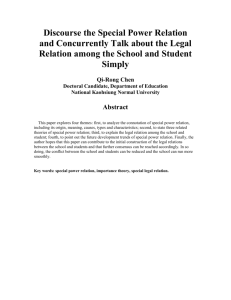

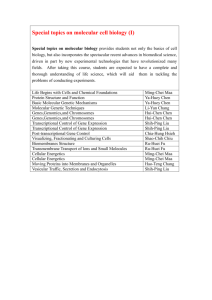
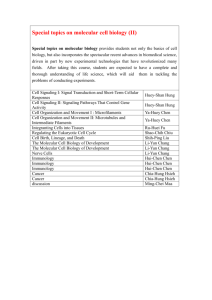
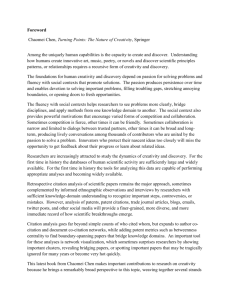
![[2015] NSWCCA 122](http://s3.studylib.net/store/data/008763482_1-5f79bafac0cf4bb0ff9b62e8fbb24293-300x300.png)
